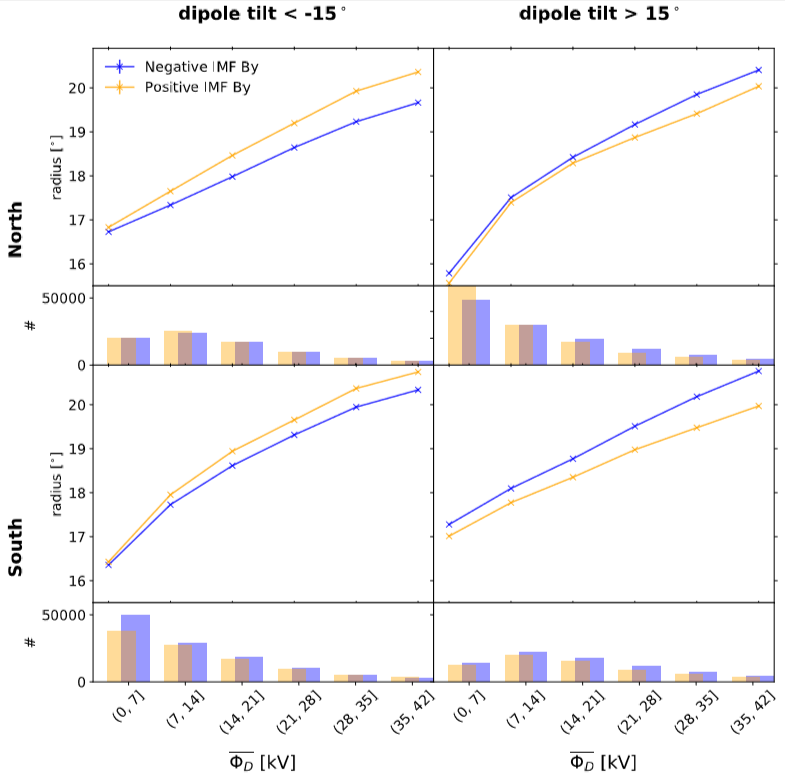An important task in the space community for almost 50 years now has been to quantify the energy input from the solar wind and into the Earth’s magnetosphere. While most researchers agree on the opening of magnetic flux through dayside reconnection as the primary mode of energy transfer, a variety of empirical coupling functions have been implemented since the 1970s. Despite their differences, these coupling functions all seem to agree that the dependence of the dawn-dusk component (By) of the interplanetary magnetic field (IMF) is the same for both positive and negative values.
However, in a recent publication by Jone Reistad and colleagues at the Dynamics of the Asymmetric Geospace Group at BCSS, they present an explicit IMF By dependence on solar wind – magnetosphere coupling. Their results show that when the Earth’s dipole is tilted in the direction corresponding to northern winter, positive IMF By is found to on average lead to a larger polar cap than when IMF By is negative during otherwise similar conditions. This explicit IMF By effect is found to reverse when the Earth’s dipole is inclined in the opposite direction (northern summer) and is consistently observed from both hemispheres.

Radius of the region 1/2 current system as deduced from AMPERE, sorted by the average dayside reconnection rate in the 2 hr interval prior to observations,  , where periods with dominating IMF By positive or negative interval has been separated. Top row show results from northern hemisphere while bottom row are results from southern hemisphere. Left column is during dipole tilt < -15
, where periods with dominating IMF By positive or negative interval has been separated. Top row show results from northern hemisphere while bottom row are results from southern hemisphere. Left column is during dipole tilt < -15  (northern winter and southern summer), and right column represents the opposite season in both hemispheres (dipole tilt >15
(northern winter and southern summer), and right column represents the opposite season in both hemispheres (dipole tilt >15  ). A larger radius is consistently observed in both hemispheres during IMF By positive (negative) when dipole tilt is negative (positive). This suggests an explicit IMF By influence on the dayside reconnection rate.
). A larger radius is consistently observed in both hemispheres during IMF By positive (negative) when dipole tilt is negative (positive). This suggests an explicit IMF By influence on the dayside reconnection rate.
To explain why they started to look into the IMF By dependence on the solar wind – magnetosphere coupling, Jone Reistad points to Finland: “Lauri Holappa and his colleagues at the University of Oulu published two exciting papers (Holappa et al, 2019; Holappa and Mursula, 2018), indicating that there is more to the IMF By component than previously thought. So we decided to investigate the importance of the sign of IMF By, and so far it looks like this has been time well spent”!
According to Reistad, it is not only the size of the polar cap and ionospheric currents that appear to be related to the sign of the IMF By and the Earth’s dipole orientation: “The most recent publication from the Oulu group shows that the energetic particle precipitation also seem to depend on IMF By and dipole tilt in a very similar manner as the polar cap size does” Reistad explains. “Together with our results of the polar cap size, these analyses strongly suggests that at least an important part of the observed explicit IMF By effect is due to unknown aspects of solar wind – magnetosphere interactions, and not solely a result of hemispheric differences in ionospheric conditions, as suggested earlier.
At the moment, the challenge is to understand the underlying mechanisms to explain the IMF By dependence: “We are not there yet, but hopefully we will be able to come up with an explanation that links the observations of ionospheric currents, polar cap sizes and energetic particle precipitation with the sign of the By component. One possible outcome is a better way to quantify the energy input from the solar wind and into the Earth’s magnetosphere”.




